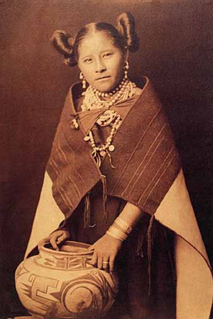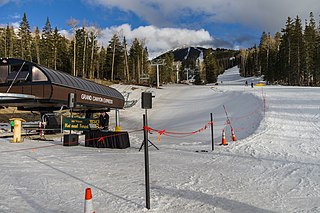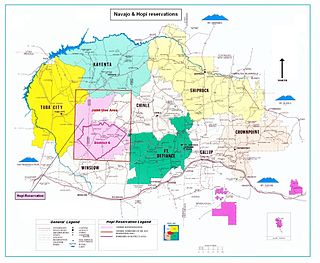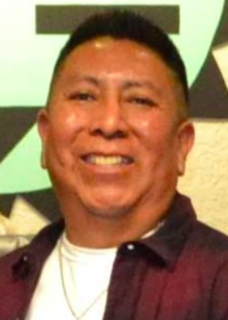Related Research Articles

The Hopi are a Native American tribe who primarily live on the Hopi Reservation in northeastern Arizona. As of the 2010 census, there are 19,338 Hopi in the United States. The Hopi Tribe is a sovereign nation within the United States and has government-to-government relations with the United States federal government. Particular villages retain autonomy under the Hopi Constitution and Bylaws. The Hopi language is one of 30 in the Uto-Aztecan language family. The majority of Hopi people are enrolled in the Hopi Tribe of Arizona but some are enrolled in the Colorado River Indian Tribes. The Hopi Reservation covers a land area of 2,531.773 sq mi (6,557.26 km2).

Coconino County is a county located in the north-central part of the U.S. state of Arizona. Its population was 134,421 at the 2010 census. The county seat is Flagstaff. The county takes its name from Cohonino, a name applied to the Havasupai people. It is the second-largest county by area in the contiguous United States, behind San Bernardino County, California. It has 18,661 sq mi (48,300 km2), or 16.4% of Arizona's total area, and is larger than each of the nine smallest states in the U.S.

Tuba City is an unincorporated town in Coconino County, Arizona, on the Navajo Nation, United States. It is the second-largest community in Coconino County. The population of the census-designated place (CDP) was 8,611 at the 2010 census.

Second Mesa is a census-designated place (CDP) in Navajo County, Arizona, on the Hopi Reservation, atop the 5,700-foot mesa. As of the 2010 census, the CDP population was 962, spread among three Hopi Indian villages, Musungnuvi, Supawlavi, and Songoopavi. The Hopi Cultural Center is on Second Mesa.

The Navajo Nation is a Native American territory covering about 17,544,500 acres, occupying portions of northeastern Arizona, southeastern Utah, and northwestern New Mexico in the United States. This is the largest land area retained by a Native American tribe in the United States. In 2010, the total population of Navajo tribal members was 332,129 with 173,667 living within the boundaries of the reservation and 158,462 tribal members outside of the reservation. Metropolitan areas accounted for 26 percent of the population, border towns accounted for ten percent, and the remaining 17 percent were living elsewhere in the U.S.

The Four Corners is a region of the Southwestern United States consisting of the southwestern corner of Colorado, southeastern corner of Utah, northeastern corner of Arizona, and northwestern corner of New Mexico. The Four Corners area is named after the quadripoint at the intersection of approximately 37° north latitude with 109° 03' west longitude, where the boundaries of the four states meet, and are marked by the Four Corners Monument. It is the only location in the United States where four states meet. Most of the Four Corners region belongs to semi-autonomous Native American nations, the largest of which is the Navajo Nation, followed by Hopi, Ute, and Zuni tribal reserves and nations. The Four Corners region is part of a larger region known as the Colorado Plateau and is mostly rural, rugged, and arid. In addition to the monument, commonly visited areas within Four Corners include Monument Valley, Mesa Verde National Park, Chaco Canyon, Canyons of the Ancients National Monument and Canyon de Chelly National Monument. The most populous city in the Four Corners region is Farmington, New Mexico, followed by Durango, Colorado.
Native Americans have inhabited what is now Arizona for thousands of years. It remains a state with one of the largest percentages of Native Americans in the United States, and has the second largest total Native American population of any state. In addition, the majority of the Navajo Nation, the largest Native American reservation in the US, and the entire Tohono O'odham Nation, the second largest, are located in Arizona. Over a quarter of the area of the state is reservation land.

An Indian reservation is an area of land tenure governed by a federally recognized Native American tribal nation under the U.S. Bureau of Indian Affairs, rather than by the government of the state in which it is located. The 326 Indian reservations in the United States are associated with specific Native American nations, often on a one-to-one basis. Some of the country's 574 federally recognized tribes govern more than one reservation, while some share reservations, and others have no reservation at all. In addition, because of past land allotments, leading to sales to non–Native Americans, some reservations are severely fragmented, with each piece of tribal, individual, and privately held land being a separate enclave. This jumble of private and public real estate creates significant administrative, political and legal difficulties.

Northern Arizona is an unofficial, colloquially-defined region of the U.S. state of Arizona. Generally consisting of Apache, Coconino, Mohave, Navajo, and Gila counties, the region is geographically dominated by the Colorado Plateau, the southern border of which in Arizona is called the Mogollon Rim.

The Hopi Reservation is a Native American reservation for the Hopi and Arizona Tewa people, surrounded entirely by the Navajo Nation, in Navajo and Coconino counties of Arizona, United States. The site in north-eastern Arizona has a land area of 2,531.773 sq mi (6,557.262 km²) and as of the 2000 census had a population of 6,946. The Hopi Reservation, like most of Arizona but unlike the surrounding Navajo Nation, does not observe daylight saving time. Until 1974, the two nations shared the Navajo–Hopi Joint Use Area, until the Navajo-Hopi land settlement act created an artificial boundary through the area. The partition of this area, commonly known as Big Mountain, by Acts of Congress in 1974 and 1996, has resulted in continuing controversy. The system of villages unites three mesas in the pueblo style traditionally used by the Hopi. Walpi is the oldest village on First Mesa, having been established in 1690 after the villages at the foot of mesa Koechaptevela were abandoned for fear of Spanish reprisal after the 1680 Pueblo Revolt. The Tewa people live on First Mesa. Hopi also occupy the Second Mesa and Third Mesa. The community of Winslow West is off-reservation trust land of the Hopi tribe. The Hopi Tribal Council is the local governing body consisting of elected officials from the various reservation villages. Its powers were given to it under the Hopi Tribal Constitution. The Hopi consider their life on the reservation an integral and critically sustaining part of the "fourth world". Hopi High School is the secondary education institute for reservation residents. Hopi Radio, a station with a mix of traditional Hopi and typical American programming is run for the reservation and provides internships for Hopi High School.

The Colorado River Indian Tribes is a federally recognized tribe consisting of the four distinct ethnic groups associated with the Colorado River Indian Reservation: Chemehuevi, the Mohave, Hopi, and Navajo. The tribe has about 4,277 enrolled members. A total population of 9,485 currently resides within the tribal reservation according to the 2012-2016 American Community Survey data.

Arizona Snowbowl is an alpine ski resort in the southwest United States, located on the San Francisco Peaks of northern Arizona, seven miles (11 km) north of Flagstaff. The Snowbowl ski area covers approximately one percent of the San Francisco Peaks, and its slopes face west and northwest.

Fred Kabotie was a celebrated Hopi painter, silversmith, illustrator, potter, author, curator and educator. His native name in the Hopi language is Naqavoy'ma which translates to Day After Day.

Polacca is an unincorporated community in Navajo County, of northeastern Arizona, United States. It is Hopi-Tewa community on the Hopi Reservation.

The Bureau of Indian Education (BIE), headquartered in the Main Interior Building in Washington, D.C., and formerly known as the Office of Indian Education Programs (OIEP), is a division of the U.S. Department of the Interior under the Assistant Secretary for Indian Affairs. It is responsible for the line direction and management of all BIE education functions, including the formation of policies and procedures, the supervision of all program activities, and the approval of the expenditure of funds appropriated for BIE education functions.

The Kayenta mine was a surface coal mine operated by Peabody Western Coal Company on the Navajo Nation in northern Arizona from 1973 to 2019. About 400 acres are mined and reclaimed each year, providing about 8 million tons of coal annually to the Navajo Generating Station.

The Bennett Freeze was a 43-year development ban on 1.5 million acres of Navajo lands by the US Federal Government. It was put in place in 1966 in order to promote negotiations over a land dispute between the Navajo and the Hopi and lasted until 2009. It was named for the Commissioner of Indian Affairs at the time, Robert L Bennett, and meant that in the "frozen" area, no development at all could occur. This included fixing roofs, building houses, constructing gas and water lines, and repairing roads.
Patty Talahongva is a Hopi journalist, documentary producer, and news executive. She was the first Native American anchor of a national news program in the United States and is involved in Native American youth and community development projects. A past president of the Native American Journalists Association, she was the recipient of their Medill Milestone Achievement Award in 2016. In 2019, she was hired as the news executive for the national television news program developed by Indian Country Today at Arizona State University.
Martha Blue is an American lawyer and author. She is a partner in the Arizona law firm of Wade and Blue.

Timothy Nuvangyaoma is a Hopi politician and firefighter. He serves as the chairperson and tribal leader of the Hopi Reservation in Arizona in the United States.
References
- 1 2 "Radio Provides Vital Information To Rural Tribes". NPR. 2009-07-19. Retrieved 2012-11-27.
- 1 2 "Shooting Stars Hopi Lavayi Radio Project - KUYI". kuyi.net. Retrieved 2012-11-27.
- ↑ Jesse Hardman, Maura R. O'Connor (2009-06-19). "Tribal Radio". Transom.org, a Showcase & Workshop for New Public Radio. Retrieved 2012-11-27.
- ↑ Alexis Hauk (2012-08-15). "Radio Free Cherokee: Endangered Languages Take to the Airwaves". The Atlantic. Retrieved 2012-11-27.
- 1 2 Laurel Morales (2012-02-24). "Radio Essential To Tribes". Fronteras Desk. Retrieved 2012-11-27.
- ↑ Michelle Tirado (2009-04-28). "More Native American Radio Stations Broadcast Via the Web". Yahoo! Voices. Archived from the original on 2013-02-09. Retrieved 2012-11-27.
- ↑ "KUYI Hopi radio hosts 'Listener Choice' awards - Navajo-Hopi Observer - Flagstaff, Arizona". Archived from the original on 2012-11-09. Retrieved 2012-11-27.
- ↑ "KUYI Informs Community During Crises". National Center for Media Engagement. Retrieved 2012-11-27.